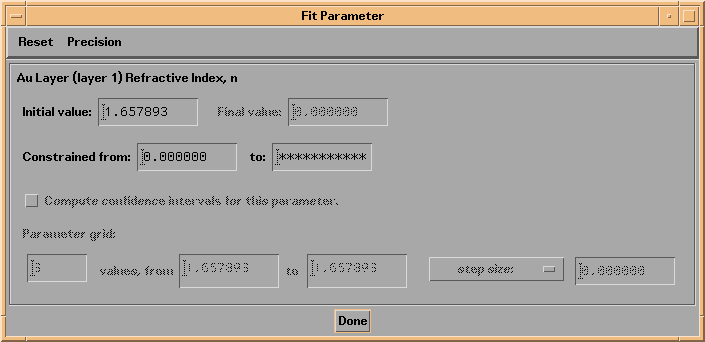
To perform a fit to your measured data, you must specify which parameters you wish to vary. As in the case of selecting independent variables, any parameters that describe the structure or the incident 'beam' can be chosen to be fit parameters (so long as they are not already designated as independent variables or coupled parameters.) So before specifying fit parameters, make sure the structure and independent variables are defined appropriately.
Continuing with our example (having already specified the structure as a single Au film, 40 nm thick,) to designate fit parameters select the FIT PARAMETERS button on the main IMD widget, as in Figure 3.2.1:
Figure 3.2.1 The main IMD widget as it appears when the FIT PARAMETERS button is selected.

Now press the Add button on the FIT PARAMETERS page. You will be presented with the list of available fit parameters. You can choose as many parameters as you like, so long as the number of data points available is greater than the number of fit parameters.
Note: The structure parameters you choose as fit parameters will be indicated as such in the Structure List after the fit is completed.
In this example, I will choose two fit parameters: the refractive index, n, and the extinction coefficient, k of the Au film.
For each fit parameter selected, IMD will create a Fit Parameter widget that allows you to specify an initial value for the parameter, and, optionally, constraints on the range of acceptable fit values.
Figure 3.2.2 shows the Fit Parameter widget corresponding to the refractive index of Au. The initial value is automatically set to the value of n for Au at 400 nm obtained from the IMD optical constant database, i.e., n=1.657893. Likewise, the initial value for k is automatically set to 1.95601.
Figure 3.2.2 Fit Parameter widget example.

Note: It's important to specify initial parameter values that are as close to the actual values as possible, or else the fitting algorithm may not converge. Although the actual parameter values are usually unknown (which is probably why you're doing a fit), try to make as good a guess as you can.
For our example, to make things (slightly) more interesting, I will set the initial values for n and k to be far from the actual values; I'll choose initial values of (n,k)=(1.,1.). To see what happens in this thrilling example, go to the Next page...